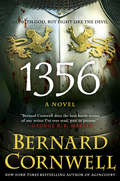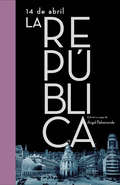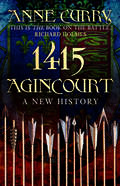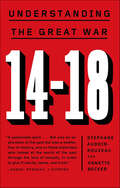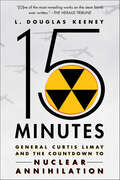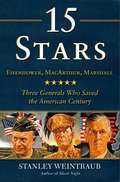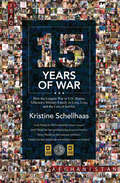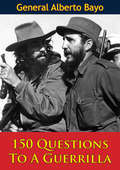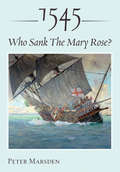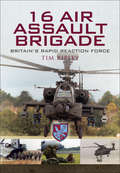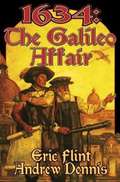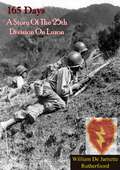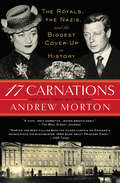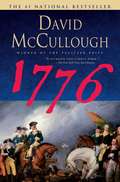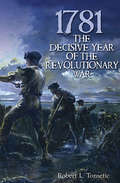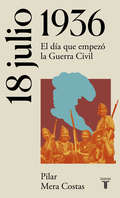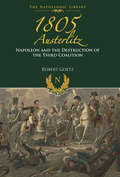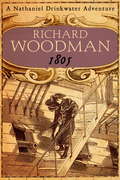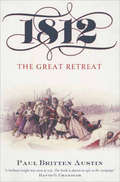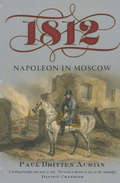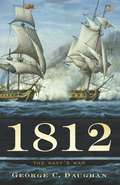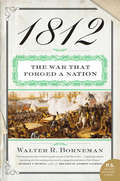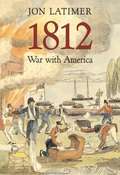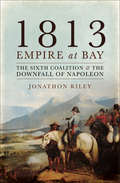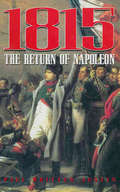- Table View
- List View
1356
by Bernard Cornwell"The most prolific and successful historical novelist in the world today" (Wall Street Journal) has delivered another blockbuster with this thrilling tale of peril and conquest at the Battle of Poitiers.September 1356. All over France, towns are closing their gates. Crops are burning, and through-out the countryside people are on the alert for danger. The English army--led by the heir to the throne, the Black Prince--is set to invade, while the French, along with their Scottish allies, are ready to hunt them down.But what if there was a weapon that could decide the outcome of the imminent war?Thomas of Hookton, known as le Batard, has orders to uncover the lost sword of Saint Peter, a blade with mystical powers said to grant certain victory to whoever possesses her. The French seek the weapon, too, and so Thomas's quest will be thwarted at every turn by battle and betrayal, by promises made and oaths broken. As the outnumbered English army becomes trapped near Poitiers, Thomas, his troop of archers and men-at-arms, his enemies, and the fate of the sword converge in a maelstrom of violence, action, and heroism.Rich with colorful characters, great adventure, and thrilling conflict, 1356 is a magnificent tale of how the quest for a holy relic with the power to change history may culminate in an epic struggle.
14 de abril. La República
by Ángel BahamondeUna entretenida lección de historia de la mano de los protagonistas de la nueva serie de TVE. Primavera de 1931. El pueblo de Madrid se ha levantado en masa para celebrar la proclamación de la II República. La capital bulle ante los cambios y vive una nueva época de libertades sin precedentes. Pero, mientras unos celebran el cambio de Gobierno, otros se preparan para la lucha. El 14 de abril de 1931 se abre uno de los períodos más intensos de la historia reciente de España. Primaveral e inesperada, la II República conquistó, pese a su brevedad, libertades apenas imaginadas hasta entonces por los españoles: el voto femenino, la educación laica en aulas mixtas o la legalización del divorcio, modificaron sustancialmente los usos y las costumbres de la sociedad. Nuevos aires empezaron a soplar por todo el país, y junto a ellos viajaron el arte, el cine y la literatura. Se celebró la primera edición de la vuelta ciclista e,incluso la selección española disputó su primera final en un mundial de fútbol. Una reconstrucción rigurosa y amena de toda una época a cargo de Ángel Bahamonde, catedrático de historia y asesor de las series 14 de abril. La República y La Señora, quien a través de sus protagonistas nos presenta una nueva forma de acercarnos a unos años que cambiaron la historia, en los que el sueño de un futuro moderno e igualitario, que llenó de euforia las calles en una ola de entusiasmo popular desconocida hasta entonces, tuvo que enfrentarse a otra realidad inestable y violenta, que politizó a la Iglesia y a los estudiantes, y que puso en pie de guerra a militares y terratenientes. Un libro de historia lleno de historias, que nos enseñará las claves para entender lo sucedido en un país que se acostó monárquico y despertó, una mañana de abril, republicano.
1415 Agincourt: A New History
by Anne CurryFor many commentators then and now, it was the English archers who won the day for Henry V. This lavishly illustrated history re-tells the story of the battle and Henry V's Normandy campaign from the perspective of the commander of the English archers, Sir Thomas Erpingham. Sir Thomas, an experienced warrior with military experience dating back 40 years is known for his brief but pivotal appearances in Shakespeare's Henry V, where he is correctly portrayed as an elderly, white haired veteran. At 57 he was one of the oldest there and a close personal confident of the King. But what was his background? How did he command his archers to such a place in history? And what role did the longbow and battlefield tactics play in the final analysis of victory?
14–18: Understanding the Great War
by Annette Becker Stéphane Audoin-RouzeauWith this brilliantly innovative book, reissued for the one-hundredth anniversary of the beginning of the First World War, Stéphane Audoin-Rouzeau and Annette Becker have shown that the Great War was the matrix from which all subsequent disasters of the twentieth century were formed. They identify three often neglected or denied aspects of the conflict that are essential for understanding the war: First, what inspired its unprecedented physical brutality, and what were the effects of tolerating such violence? Second, how did citizens of the belligerent states come to be driven by vehement nationalistic and racist impulses? Third, how did the tens of millions bereaved by the war come to terms with the agonizing pain? With its strikingly original interpretative strength and its wealth of compelling documentary evidence, 14–18: Understanding the Great War has established itself as a classic in the history of modern warfare.
15 Minutes: General Curtis LeMay and the Countdown to Nuclear Annihilation
by L. Douglas KeeneyPacked with startling revelations, this inside look at the secret side of the Cold War exposes just how close America came to total annihilation During the Cold War, a flight crew had 15 minutes to get their nuke-laden plane in the air from the moment Soviet bombers were detected—15 minutes between the earliest warning of an incoming nuclear strike and the first flash of an enemy warhead. This is the chilling true story of the incredibly risky steps our military took to protect us from that scenario, including: • Over two thousand loaded bombers that crossed American skies. They sometimes crashed and at least nine times resulted in nuclear weapons being accidentally dropped • A system that would use timers and rockets to launch missiles even after everyone was dead • Disastrous atmospheric nuclear testing including the horrific runaway bomb—that fooled scientists and put thousands of men in uniform in the center of a cloud of hot fallout • A plan to use dry lake beds to rebuild and launch a fighting force in the aftermath of nuclear war Based on formerly classified documents, military records, press accounts, interviews and over 10 years of research, 15 Minutes is one of the most important works on the atom bomb ever written.
15 Stars: Three Generals Who Saved the American Century
by Stanley WeintraubIn the closing days of World War II, America looked up to three five-star generals as its greatest heroes. George C. Marshall, Dwight D. Eisenhower, and Douglas MacArthur personified victory, from the Pentagon to Normandy to the Far East. Counterparts and on occasion competitors, they had leapfrogged each other, sometimes stonewalled each other, even supported and protected each other throughout their celebrated careers. In the public mind they stood for glamour, integrity, and competence. But for dramatic twists of circumstance, all three -- rather than only one -- might have occupied the White House. The story of their interconnected lives opens a fascinating window onto some of the twentieth century's most crucial events, revealing the personalities behind the public images and showing how much of a difference three men can make. Marshall and MacArthur were contemporaries and competitors. Eisenhower was MacArthur's underling, then Marshall's deputy, before becoming MacArthur's counterpart as a supreme commander, Ike in Western Europe, MacArthur in the Pacific. Each of the three five-star generals would go on to extraordinary postwar careers: MacArthur as a virtual viceroy of Japan, overseeing its transition to a new constitutional democracy, and then leading the UN forces in the Korean War; Marshall as secretary of state, author of the Marshall Plan, and winner of the Nobel Peace Prize; Eisenhower as president. Fifteen Stars presents the intertwined lives of these three great men against the sweeping background of six unforgettable decades, from two world wars to the Cold War. It is history at its most dramatic yet most personal -- a triumph for Stanley Weintraub, our preeminent military historian.
15 Years of War: How the Longest War in U.S. History Affected a Military Family in Love, Loss, and the Cost of Service
by Kristine Schellhaas&“First-time author Schellhaas presents a moving memoir of her life with her husband, Ross . . . after [he] is deployed to Iraq after the events of 9/11.&” —Publishers Weekly Less than 1 percent of our nation will ever serve in our armed forces, leaving many to wonder what life is really like for military families. He answers the call of duty in Afghanistan, Iraq, and the Pacific; she keeps the home fires burning. Worlds apart, and in the face of indescribable grief, their relationship is pushed to the limits. 15 Years of War provides a unique he said/she said perspective on coping with war in modern-day America. It reveals a true account of how a dedicated Marine and his equally committed spouse faced unfathomable challenges and achieved triumph, from the days just before 9/11 through fifteen years of training workups, deployments, and other separations. This story of faith, love, and resilience offers insight into how a decade and a half of war has redefined what it means to be a military family. &“[A] tough-minded but open-hearted memoir . . . a frank description of what it takes for a spouse and family to support a soldier. The Schellhaases&’ story is deeply personal and unique, but it will resonate with other families, both civilian and military.&” —Foreword Magazine &“Kristine Schellhaas is a beautiful and transcendent voice of truth and consequence, and her memoir, 15 Years of War, should be required reading for every American who wants to understand just exactly what they have asked of the chosen 1 [percent].&” —Angela Ricketts, author of No Man&’s War: Irreverent Confession of an Infantry Wife
150 Questions To A Guerrilla
by General Alberto BayoGeneral Alberto Bayo is possibly the one individual most responsible for Fidel Castro's military successes against the Batista regime. Find the answers to such questions as: What is the most efficient size of a guerrilla unit? How will new volunteers be trained? What should be done if the enemy fire on us by surprise?
1545: Who Sank The Mary Rose?
by Peter MarsdenA &“wonderful&” account of the raising of a sixteenth-century warship, and answers to the long-running mysteries surrounding her loss (Naval Historical Foundation). In 1982, a Tudor Navy warship was raised in a major salvage project that represented a landmark in maritime archaeology. The Mary Rose had spent over four centuries underwater, and contained the skeletons of numerous sailors as well as many fascinating artifacts of the time. She is more than a relic, however. She has a story to tell, and her sinking in the Solent while under attack by the French, and the reasons for it, have intrigued historians for generations. With the benefit of access to her remains, archaeologists have been able to slowly unravel the mystery of her foundering on a calm summer&’s day in July 1545. This new book by a leading expert on the Mary Rose contains much information that is published for the first time. It provides the first full account of the battle in which Henry VIII&’s warship was sunk, and tells the stories of the English and French admirals. It examines the design and construction of the ship and how she was used, and finally makes clear who was responsible for the loss of the Mary Rose, after describing what happened onboard, deck by deck, in her last moments afloat. Includes photographs
16 Air Assault Brigade: Britain's Rapid Reaction Force
by Tim RipleyAfter the S.A.S., 16 Brigade is the most high profile formation in the British Army but to date there has been no complete history of its operations and activities. The aim of this book is to produce a history of Britains Elite Rapid Reaction Force 16 Air Assault Brigade.It will provide a historical narrative of 16 Brigades operations since its formation in 1999. It explains the innovative tactics and operational procedures used by to move by air into battle. It covers military hardware, the Brigade has some of the UKs most advanced weapon system, including Apache attack helicopters. It will include the elite combat units including the Parachute Regiment and Pathfinders. Key personalities from the Brigade will be examined together with a comprehensive analysis of how the Brigade has performed and how it is likely to evolve in coming years.The Brigade is due to return to Afghanistan in 2008 so its public profile will remain high.
1634: The Galileo Affair
by Eric Flint Andrew DennisEUROPEAN CUNNING MEETS AMERICAN COURAGE The Thirty Years War continues to ravage 1 7th century Europe, but a new force is gathering power and influence: the United States of Europe, forged by an alliance between Gustavus Adolphus, King of Sweden, and the West Virginians from the 20th century led by Mike Stearns who were hurled centuries into the past by a mysterious cosmic accident. The democratic ideals of the USE have aroused the implacable hostility of Cardinal Richelieu, effective ruler of France, who has moved behind the scenes, making common cause with old enemies to stop this new threat to the privileged and powerful. But the USE is also working behind the scenes. A group of West Virginians have secretly traveled to Venice where their advanced medical knowledge may prevent the recurrence of the terrible plague which recently killed a third of the city-state's population. At the same time, the group hopes to establish commercial ties with Turkey's Ottoman Empire, then at the height of its power. And, most important, they hope to establish private diplomatic ties with the Vatican, exploiting Pope Urban VIU's misgivings about the actions of Richelieu and the Hapsburgs.
165 Days: A Story Of The 25th Division On Luzon
by William De Jarnette Rutherford165 Days: A Story Of The 25th Division On Luzon by William De Jarnette Rutherfoord is a gripping and meticulously illustrated account of the 25th Infantry Division's pivotal role in the liberation of Luzon during World War II. Through vivid storytelling and firsthand accounts, Rutherfoord brings to life the harrowing experiences, intense battles, and unwavering determination of the soldiers who fought to reclaim the Philippines from Japanese occupation.The book covers the 165 days of relentless combat that defined the 25th Division’s campaign on Luzon, the largest and most strategically significant island in the Philippines. Rutherfoord, a member of the division, provides an insider's perspective on the brutal realities of jungle warfare, the challenges of supply and communication, and the indomitable spirit of the soldiers who faced overwhelming odds in their mission to secure victory.165 Days offers readers a detailed chronicle of the division’s maneuvers, from the initial landings to the final push that led to the liberation of Manila and the collapse of Japanese resistance. Rutherfoord captures the camaraderie, bravery, and sacrifices of the men in the division, highlighting both the human cost of war and the resilience of those who served.The book also delves into the strategic importance of the Luzon campaign, explaining how the actions of the 25th Division contributed to the broader Allied effort to defeat Japan in the Pacific Theater. Maps, photographs, and other illustrations complement the narrative, providing a comprehensive understanding of the terrain, tactics, and experiences of the soldiers.165 Days: A Story Of The 25th Division On Luzon is an essential read for military historians, veterans, and anyone interested in the Pacific War. William De Jarnette Rutherfoord’s compelling narrative honors the legacy of the 25th Infantry Division, offering a powerful testament to the courage and dedication of the men who fought to liberate the Philippines.This book stands as a tribute to the enduring spirit of the 25th Division, ensuring that the story of their sacrifice and triumph will never be forgotten.
17 Carnations: The Royals, the Nazis, and the Biggest Cover-Up in History
by Andrew MortonA meticulously researched historical tour de force about the secret ties among Franklin D. Roosevelt, Winston Churchill, the Duke of Windsor, and Adolf Hitler before, during, and after World War II.Andrew Morton tells the story of the feckless Edward VIII, later Duke of Windsor, his American wife, Wallis Simpson, the bizarre wartime Nazi plot to make him a puppet king after the invasion of Britain, and the attempted cover-up by Churchill, General Eisenhower, and King George VI of the duke's relations with Hitler. From the alleged affair between Simpson and the German foreign minister to the discovery of top secret correspondence about the man dubbed "the traitor king" and the Nazi high command, this is a saga of intrigue, betrayal, and deception suffused with a heady aroma of sex and suspicion.For the first time, Morton reveals the full story behind the cover-up of those damning letters and diagrams: the daring heist ordered by King George VI, the smooth duplicity of a Soviet spy as well as the bitter rows and recriminations among the British and American diplomats, politicians, and academics. Drawing on FBI documents, exclusive pictures, and material from the German, Russian, and British royal archives, as well as the personal correspondence of Churchill, Eisenhower, and the Windsors themselves, 17 CARNATIONS is a dazzling historical drama, full of adventure, intrigue, and startling revelations, written by a master of the genre.
1776: 1776, Brave Companions, The Great Bridge, John Adams, The Johnstown Flood, Mornings On Horseback, Path Between The Seas, Truman, The Course Of Human Events
by David McCulloughAmerica&’s beloved and distinguished historian presents, in a book of breathtaking excitement, drama, and narrative force, the stirring story of the year of our nation&’s birth, 1776, interweaving, on both sides of the Atlantic, the actions and decisions that led Great Britain to undertake a war against her rebellious colonial subjects and that placed America&’s survival in the hands of George Washington.In this masterful book, David McCullough tells the intensely human story of those who marched with General George Washington in the year of the Declaration of Independence—when the whole American cause was riding on their success, without which all hope for independence would have been dashed and the noble ideals of the Declaration would have amounted to little more than words on paper. Based on extensive research in both American and British archives, 1776 is a powerful drama written with extraordinary narrative vitality. It is the story of Americans in the ranks, men of every shape, size, and color, farmers, schoolteachers, shoemakers, no-accounts, and mere boys turned soldiers. And it is the story of the King&’s men, the British commander, William Howe, and his highly disciplined redcoats who looked on their rebel foes with contempt and fought with a valor too little known. Written as a companion work to his celebrated biography of John Adams, David McCullough&’s 1776 is another landmark in the literature of American history.
1781: The Decisive Year of the Revolutionary War
by Robert L. Tonsetic<p>A detailed chronicle—including eyewitness accounts—of the year American Patriots turned the tables on the British in the US War of Independence.<p> <p>In 1781, the future of America hung by a thread. British troops occupied key coastal cities, from New York to Savannah. After several harsh winters, the American army was fast approaching the breaking point. Mutinies began to emerge in George Washington’s ranks, and it was only the arrival of French troops that provided a ray of hope for the American cause.<p> <p>1781 was a year of battles, from the Patriot victory in the Battle of Cowpens, to Gen. Nathaniel Greene’s impressive Southern campaign. In the Siege of Yorktown, the French fleet, the British fleet, Greene, Washington, and the French army under Rochambeau all converged in a fateful battle that would end with Cornwallis’s surrender on October 19.<p> <p>In this book, Robert Tonsetic provides a detailed analysis of the key battles and campaigns of 1781, supported by numerous eyewitness accounts, from privates to generals in the American, French, and British armies. He also describes the diplomatic efforts underway in Europe during 1781, as well as the Continental Congress’s actions to resolve the immense financial, supply, and personnel problems involved in maintaining an effective fighting army in the field.<p>
18 de julio de 1936. Hacia la Guerra Civil española
by Pilar Mera CostasNuevo título de una colección única que cuenta nuestro largo siglo XX en siete libros para siete fechas clave. No todos los días son iguales. El 18 de julio de 1936, el Gobierno de la Segunda República se dirigió a los españoles a través de la radio para anunciar la rebelión del Ejército en Marruecos. Eran las ocho y media de la mañana. Aunque la nota intentaba transmitir calma y normalidad, la vida de todo un país se detuvo entre tiros y rumores. Después de meses conspirando, los principales mandos militares se sublevaron por toda España. Un caluroso sábado de julio se convirtió en una frenética sucesión de horas, dudas, traiciones y muerte. El golpe no triunfó, pero debilitó al Estado republicano y desencadenó la revolución que decía querer evitar. El mapa se rompió en dos. Comenzaba la Guerra Civil. COLECCIÓN LA ESPAÑA DEL SIGLO XX EN 7 DÍAS: Solemos abordar la historia a partir de arcos de tiempo dilatados. Pero ¿qué sucede si, por una vez, centramos la atención en los instantes concretos que más han marcado nuestro pasado colectivo? Los protagonistas, sus acciones, sus emociones, sus deseos, sus dudas y sus errores pasan al centro del relato, irrumpen con la fuerza de la imprevisibilidad, y los revivimos como si fuera la primera vez. En esta novedosa colección, algunos de los mejores historiadores nos muestran que nada puede darse por sentado, y cómo ciertos acontecimientos pueden dejar un rastro profundo en un país.
1805 Austerlitz: Napoleon and the Destruction of the Third Coalition
by Robert GoetzThe Battle of Austerlitz is almost universally regarded as the most impressive of Napoleons many victories. The magnitude of the French achievement against a larger army was unprecedented, the great victory being met by sheer amazement and delirium in Paris, where just days earlier the nation had been teetering on the brink of financial collapse. In this insightful study, the author analyses the planning of the opposing forces and details the course of the battle hour by hour, describing the fierce see-saw battle around Sokolnitz, the epic struggle for the Pratzen Heights, the dramatic engagement between the legendary Lannes and Bagration in the north, and the widely misunderstood clash of Napoleons Imperial Guard and Alexanders Imperial Leib-Guard. The author has produced a detailed and balanced assessment of the battle that for the first time places familiar French accounts in their proper perspective and exposes many myths regarding the battle that have been perpetuated and even embellished in recent books. With 1805: Austerlitz, the reader is left with a thorough appreciation of Napoleon and his Grande Armée of 1805, an army that decisively defeated not a hapless relic of the ancien regime but rather a formidable professional army that had fought the French armies on equal terms five years earlier.
1805: Number 6 in series (Nathaniel Drinkwater #6)
by Richard WoodmanIt is the summer of 1804 and Napoleon is massing his vast army for the invasion of England. Nathaniel Drinkwater has command of HMS Antigone, and he and his men are sent to patrol the Channel coast, helping the Royal Navy maintain a blockade of the enemy's ports. As Nelson's and Napoleon's mighty fleets draw closer to one another, Drinkwater is unprepared for the role that destiny deals him when he becomes a prisoner of the French and suddenly finds himself on the wrong side of the British bombardment.
1812: The Great Retreat
by Paul Britten Austin1812: The Great Retreat the third and final volume in Austins magisterial trilogy concludes the story of one of history's most disastrous campaigns. The author's previous books brought the Grand Army to the head-on battle at Malo-Jaroslavetz after withdrawing sixty miles from the burnt down capital, and for the first time in his meteoric career Napoleon had to order a retreat. This volume follows the army's withdrawal through 800 miles of devastated countryside, crossing the horrific relics of the Borodino battlefield, fighting its way through the Russian General Kutusov's successive attempts to cut it off, and winning, against overwhelming odds, the three-day battle of the Berezina crossing. First-hand narratives, many published in English for the first time, describe Marshal Ney's astounding achievement in holding together the rear-guard until he himself, musket in hand, was the last man to re-cross the Niemen into Poland.Using the words of the participants themselves, Paul Britten Austin brings unparalleled authenticity and immediacy to his unique account of the closing stages of Napoleon's dramatic and tragic 1812 campaign.
1812: The March On Moscow
by Paul Britten AustinThis account of Napoleon&’s disastrous invasion of Russia, in the words of those who experienced it, offers &“a brilliant insight into men at war&” (David G. Chandler, author of The Campaigns of Napoleon). Hundreds of thousands of men set out on that midsummer day of 1812. None could have imagined the terrors and hardships to come. They&’d been lured all the way to Moscow without having achieved the decisive battle Napoleon sought—and by the time they reached the city, their numbers had already dwindled by more than a third. One of the greatest disasters in military history was in the making. The fruit of more than twenty years of research, this superbly crafted work skillfully blends the memoirs and diaries of more than a hundred eyewitnesses, all of whom took part in the Grand Army&’s doomed march on Moscow, to reveal the inside story of this landmark military campaign. The result is a uniquely authentic account in which the reader sees and experiences the campaign through the eyes of participants in enthralling day-by-day, sometimes hour-by-hour detail.
1812: The Navy's War
by George C. DaughanAt the outbreak of the War of 1812, America’s prospects looked dismal. It was clear that the primary battlefield would be the open ocean-but America’s war fleet, only twenty ships strong, faced a practiced British navy of more than a thousand men-of-war. Still, through a combination of nautical deftness and sheer bravado, the American navy managed to take the fight to the British and turn the tide of the war: on the Great Lakes, in the Atlantic, and even in the eastern Pacific. In 1812: The Navy’s War, prizewinning historian George C. Daughan tells the thrilling story of how a handful of heroic captains and their stalwart crews overcame spectacular odds to lead the country to victory against the world’s greatest imperial power. A stunning contribution to military and national history, 1812: The Navy’s War is the first complete account in more than a century of how the U. S. Navy rescued the fledgling nation and secured America’s future.
1812: The War of 1812 (P. S. Series)
by Walter R. BornemanIn June 1812 the still-infant United States had the audacity to declare war on the British Empire. Fought between creaking sailing ships and armies often led by bumbling generals, the ensuing conflict featured a tit-for-tat "You burned our capital, so we'll burn yours" and a legendary battle unknowingly fought after the signing of a peace treaty. During the course of the war, the young American navy proved its mettle as the USS Constitution, "Old Ironsides," sent two first-rate British frigates to the bottom, and a twenty-seven-year-old lieutenant named Oliver Hazard Perry hoisted a flag exhorting, "Don't Give Up the Ship," and chased the British from Lake Erie. By 1814, however, the United States was no longer fighting for free trade, sailors' rights, and as much of Canada as it could grab, but for its very existence as a nation. With Washington in flames, only a valiant defense at Fort McHenry saved Baltimore from a similar fate. Here are the stories of commanding generals such as America's Henry "Granny" Dearborn, double-dealing James Wilkinson, and feisty Andrew Jackson, as well as Great Britain's gallant Sir Isaac Brock, overly cautious Sir George Prevost, and Rear Admiral George Cockburn, the man who put the torch to Washington. Here too are those inadvertently caught up in the war, from heroine farm wife Laura Secord, whom some call Canada's Paul Revere, to country doctor William Beanes, whose capture set the stage for Francis Scott Key to write "The Star-Spangled Banner." 1812: The War That Forged a Nation presents a sweeping narrative that emphasizes the struggle's importance to America's coming-of-age as a nation. Though frequently overlooked between the American Revolution and the Civil War, the War of 1812 did indeed span half a continent -- from Mackinac Island to New Orleans, and Lake Champlain to Horseshoe Bend -- and it paved the way for the conquest of the other half. During the War of 1812, the United States cast aside its cloak of colonial adolescence and -- with both humiliating and glorious moments -- found the fire that was to forge a nation.
1812: War with America
by Jon LatimerThe British viewed the War of 1812 as an ill-fated attempt by the young American republic to annex Canada. For British Canada, populated by many loyalists who had fled the American Revolution, this was a war for survival. The Americans aimed both to assert their nationhood on the global stage and to expand their territory northward and westward. Americans would later find in this war many iconic moments in their national story--the bombardment of Fort McHenry (the inspiration for Francis Scott Key's "Star Spangled Banner"); the Battle of Lake Erie; the burning of Washington; the death of Tecumseh; Andrew Jackson's victory at New Orleans--but their war of conquest was ultimately a failure. Even the issues of neutrality and impressment that had triggered the war were not resolved in the peace treaty. For Britain, the war was subsumed under a long conflict to stop Napoleon and to preserve the empire. The one lasting result of the war was in Canada, where the British victory eliminated the threat of American conquest, and set Canadians on the road toward confederation. Latimer describes events not merely through the eyes of generals, admirals, and politicians but through those of the soldiers, sailors, and ordinary people who were directly affected. Drawing on personal letters, diaries, and memoirs, he crafts an intimate narrative that marches the reader into the heat of battle.
1813: The Sixth Coalition & the Downfall of Napoleon
by Jonathon RileyA distinguished historian and British Army veteran examines the political and military alliances that led to the defeat of France in the Napoleonic Wars. 1813 was a critical year in the war that ended with the downfall of Napoleon—the year in which the balance of power tipped decisively against the French monarch&’s First Empire. In 1813: Empire at Bay, military historian and retired British Army Lt. Gen. Jonathon Riley explores the international alliance behind the major campaigns that raged across Europe and ultimately broke France&’s power. Focusing on the nations of the Sixth Coalition—Austria, Prussia, Russia, the United Kingdom, Portugal, Sweden, Spain, and the smaller German states—Riley reveals how this unprecedented alliance became the prototype of all uneasy modern coalitions. Despite their common enemy and shared goals, the international leaders and military officers had to navigate troubled command relationships, disagreements on strategy and operations, and clashing political ambitions. Riley also reassesses Napoleon&’s strengths and faults as an alliance commander, overseeing armies of not only Frenchmen but also Poles, Danes, Italians, Germans, and a host of other contingents. In vivid detail, Riley&’s groundbreaking book covers the battles of Lützen, Bautzen, Dresden, and Leipzig, demonstrating how they were each in their own way a decisive step toward Napoleon&’s defeat at Waterloo.
1815: The Return of Napoleon (The\napoleonic Library)
by Paul Britten AustinThe dramatic story of Napoleon&’s escape from Elba and march on Paris—in the words of eyewitnesses and participants. Drawing on hundreds of firsthand accounts by Napoleon&’s supporters and opponents, Paul Britten Austin recreates the drama of those tumultuous days of the spring of 1815 and throws light on the mixed French response to the unexpected return of their former emperor. 1815: The Return of Napoleon recreates, in the words of those present, Napoleon&’s dramatic landing at Antibes in the south of France; the first heady days of his arrival after almost a year of exile; his almost miraculous march across France; his arrival in Paris; and the coup which led to the fall of the Bourbons. Paul Britten Austin, author of an acclaimed trilogy on Napoleon&’s invasion of Russia, brings historical events to life and gives a dramatic insight into the hopes and fears of the French nation in that spring of 1815.
